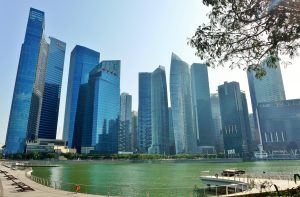The Government of Singapore is harnessing technology to build the future Singapore. The Minister for National Development, Mr Lawrence Wong, said this at the Fourth South Asian Diaspora Convention on Nov 16.
“We are doing everything we can to harness technology to build our future city. You will hear a lot about technology in different sectors, be it in finance, IT, digital technologies. You do not hear a lot about technology in the urban environment. But increasingly, we are seeing more signs of urban tech, or you can call it smart cities, but it is a technology being deployed in all the different areas of the urban built environment.
First, technology is already changing the way we plan our city. The tools needed for urban and master planning traditionally are your base maps, your geological data, land-use surveys – all that used to be paper-based. Now, all of these are digitalised. They are made widely available to planners and architects, and it allows for more detailed planning, assessment and visualisation. It is changing the way we plan and design our content and it is having an impact.”
Mr Wong illustrated how it is harnessing technology to have a much better understanding of demographics of people living in various housing estates.
“To give an illustration, when we plan for a new housing estate in Singapore nowadays, we have a much better understanding of the demographics of the people living in the town. We understand where the elderly populations are, we know where the vulnerable elderly are living, those with low income or zero income or who are living by themselves. We know then where are the gaps in terms of eldercare provisions, and we can start putting in place appropriate interventions to make sure that suitable eldercare facilities are sited in areas that are conveniently accessible by these residents. That is a very simple example of how technology is already helping us to plan better.”
The Government is also disrupting traditional methods of construction by harnessing technology.
“Second, technology is helping us to build better. It is changing the way we build. The traditional methods of construction tend to be very labour intensive, low in productivity. But increasingly, we are seeing more advanced pre-fab and pre-cast, or what we call Design for Manufacturing and Assembly (DfMA). In other words, lots of the construction is done, almost like a manufacturing line, off site. It is then brought into site and assembled, almost like a lego building block. It is a different method of construction. It is much faster, it reduces manpower and makes the construction site safer, cleaner, less noisy and with fewer dis-amenities. This is becoming pervasive – technology is changing the way we build.
Technology is changing the way we maintain and manage our infrastructure. You can have sensors. You can start to put in place a whole range of equipment to look at how buildings can be better maintained. In Singapore, for example, we have a lot of high-rise apartments. From time to time, we need to inspect the buildings for cracks along the facades. We call this facade inspection today. The way to do this is to drop a gondola and manually, the workers have to go down floor by floor to inspect. It is expensive and labour intensive.
We are starting to use drones, so that the drones can take images, and with some form of machine learning or AI algorithm, you can, through the images, start to do predictive maintenance. We are putting sensors across all our lifts in public housing apartments. The sensors can monitor the performance of the lifts. They can detect anomalies and pick up potentially something that is not functioning as well. Predictive maintenance can then be done, even before the lift breaks down. We are putting sensors in lamp posts all over the streets and there is typically a command centre that allows you to monitor and make full use of all of this data. So technology can be helpful in changing and improving the way we look at building maintenance and facilities management.”

The Minister also explained how the Government is harnessing technology which is changing how people commute, and even using it to develop new districts.
“Technology is changing the way we move around. We are starting to see new forms of transportation, even autonomous vehicles. We are starting to pilot and testbed autonomous vehicles in Singapore. We are doing this pilot across the entire western part of Singapore, and as we design and build a new housing estate in the western part of Singapore, we are looking at potentially having last-mile solutions offered through an autonomous shuttle that will operate on the roads. This sounds futuristic, but it is coming, and it can be a game changer in the way we think about transport solutions.
These are technologies that are happening all around the world. We are harnessing them, deploying them not just at the building level, but across entire districts. In Singapore, we are starting to develop some new districts, new clusters for digital districts, for innovation districts. When we build a new district, we can deploy all of these technologies, be it smart buildings, intelligent transport systems, smart sensors, and all connected together via the 5G network.
We are already calling tenders for standalone 5G networks. The first provision of 5G in Singapore might be ready by next year, which is very soon. By 2022, we expect more than half of Singapore to be 5G ready. Some of you are still on 3G, most of you are on 4G. In two years’ time, 5G. Video streaming, all sorts of apps can be done much faster than what it is today.
That’s the first thrust of our infrastructure work, to make the infrastructure smarter, much smarter than what it is today in order to bring greater convenience to the lives of Singaporeans, in order to provide a better living environment.”






